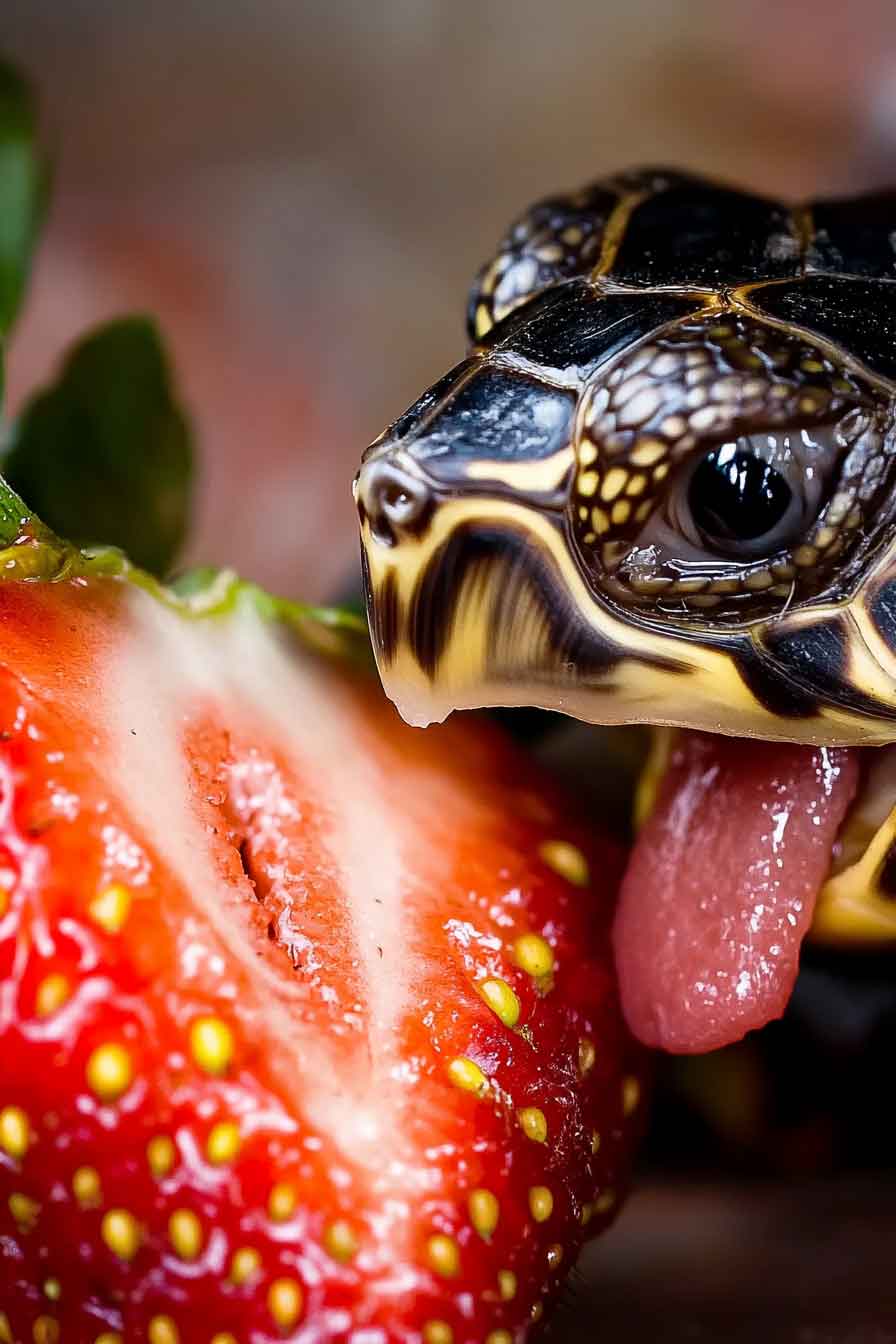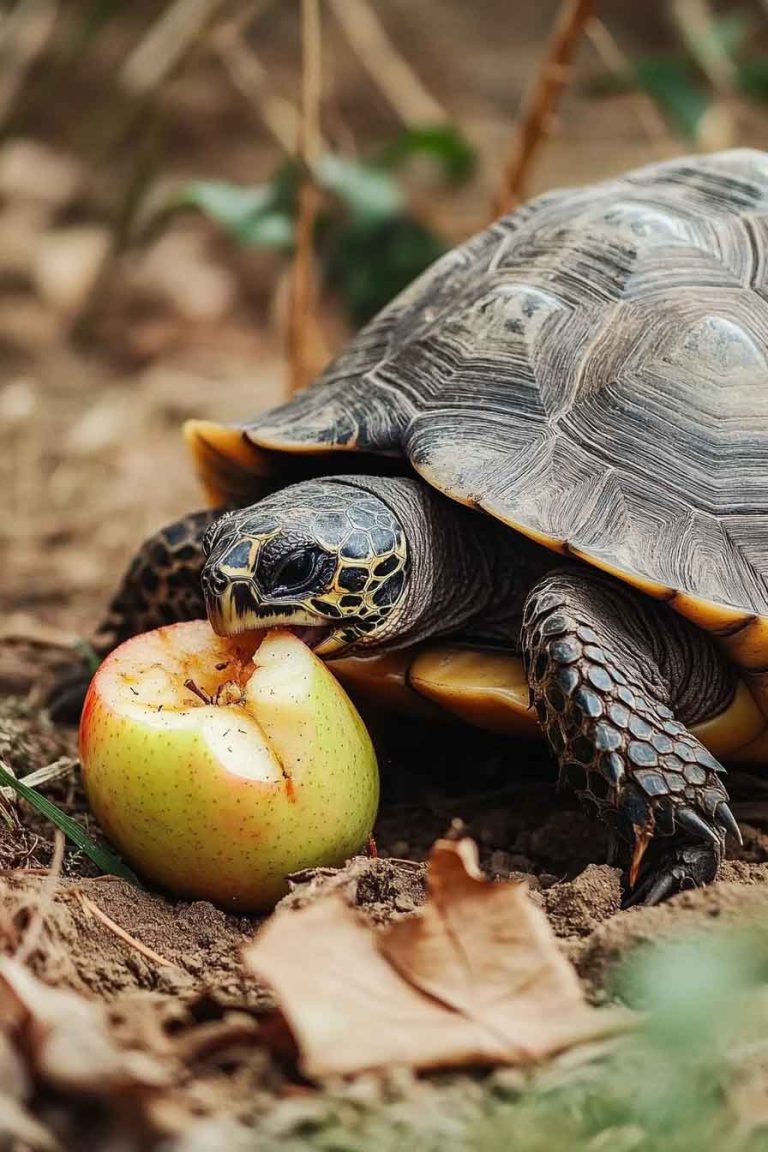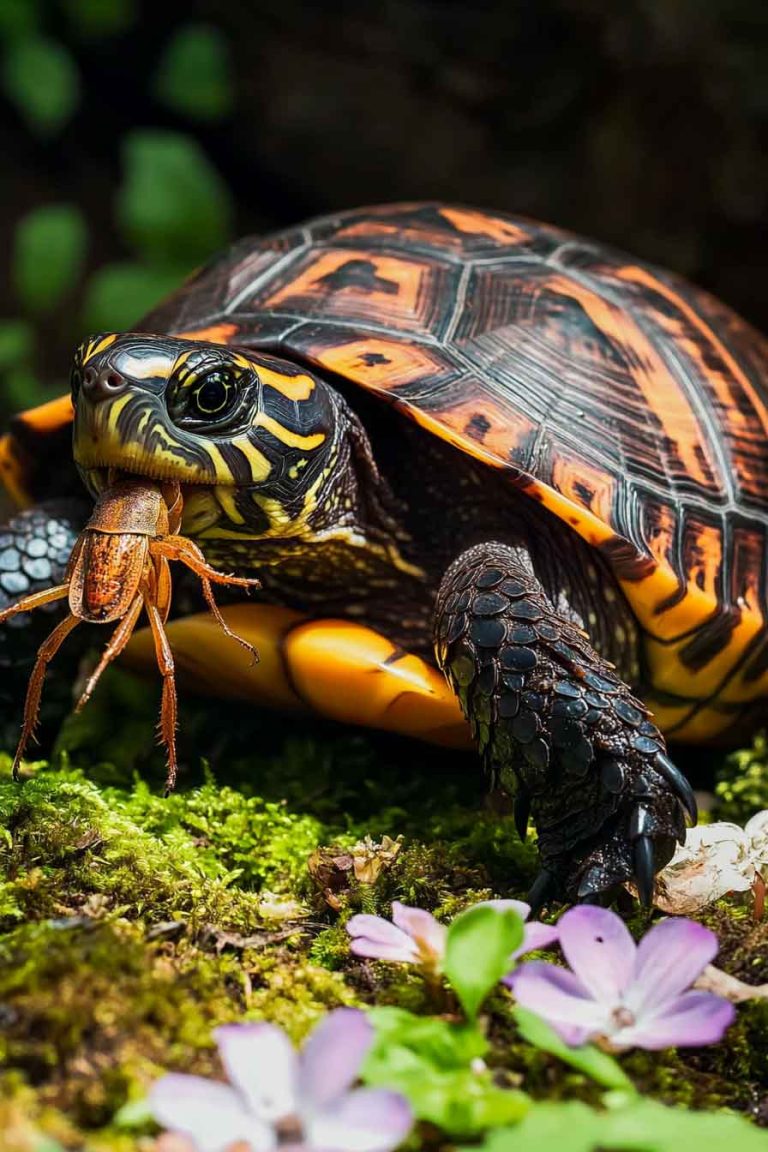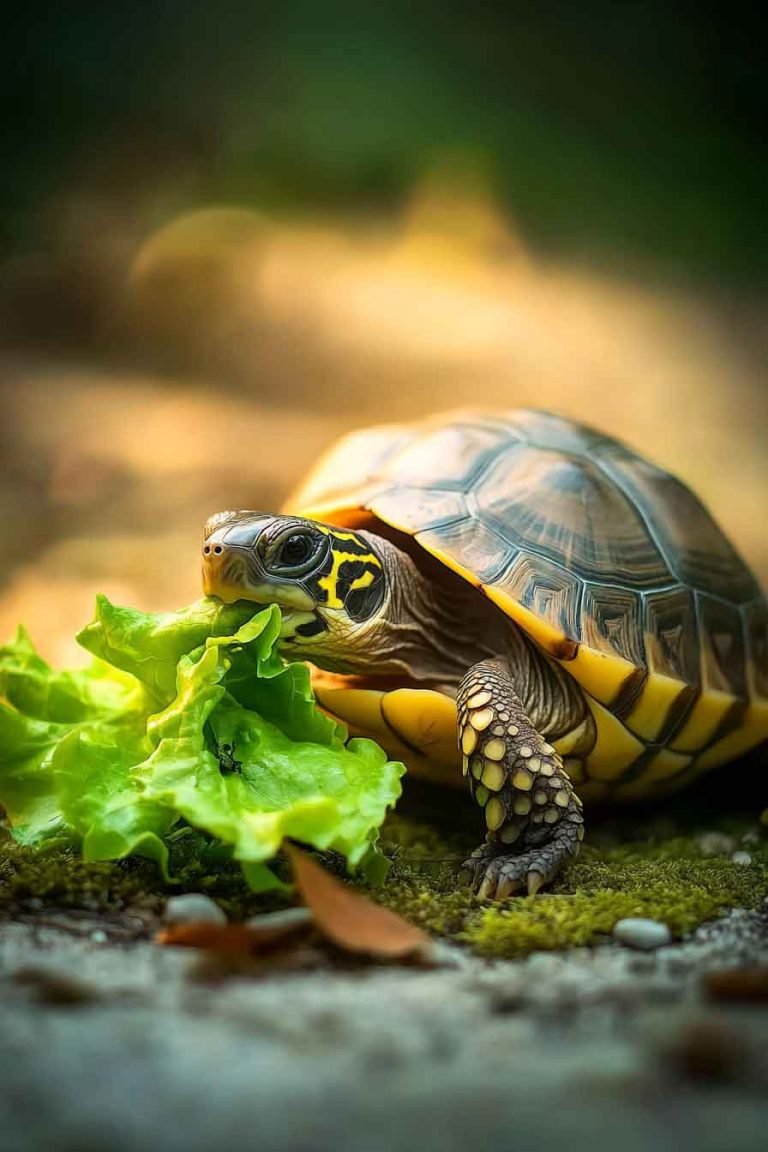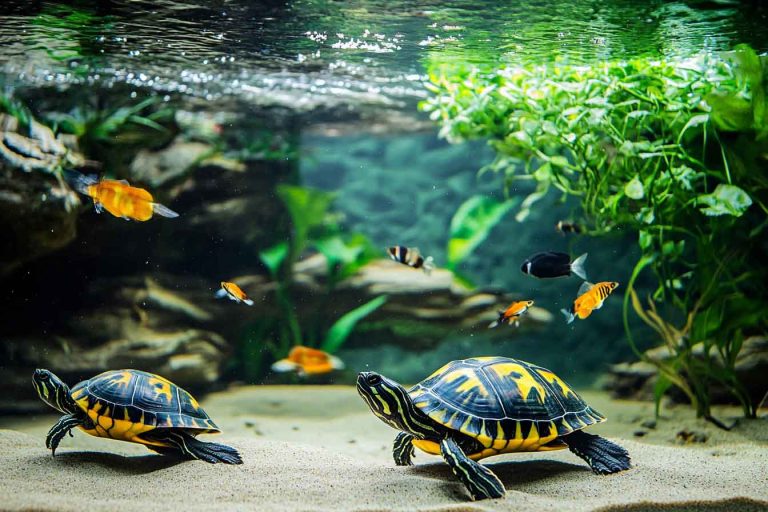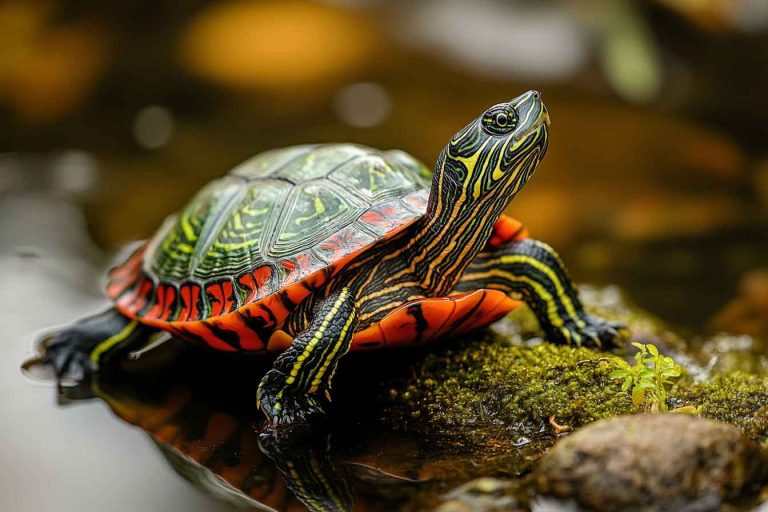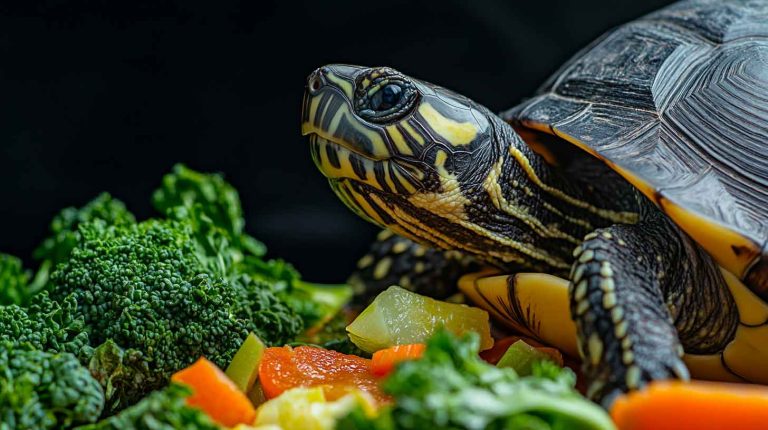Can Turtles Eat Strawberries? Safe or Not for Your Pet?
If you’re a turtle parent like me, I bet you’ve found yourself wondering whether you can share your favorite fruits with your shelled companion. I know I have! Just last week, I was enjoying some fresh strawberries when my turtle gave me those curious eyes that seemed to say, “Can I have some too?” This…
If you’re a turtle parent like me, I bet you’ve found yourself wondering whether you can share your favorite fruits with your shelled companion. I know I have! Just last week, I was enjoying some fresh strawberries when my turtle gave me those curious eyes that seemed to say, “Can I have some too?” This got me thinking about whether strawberries are safe for our turtle friends.
So, can turtles eat strawberries? The answer is yes – turtles can eat strawberries, but only as an occasional treat! While strawberries aren’t toxic to turtles like some other foods, they should be given sparingly due to their high sugar content. I always recommend treating strawberries as a special snack rather than a regular part of your turtle’s diet.
In this comprehensive guide, I’m going to share everything I’ve learned about feeding strawberries to turtles. From nutritional benefits to potential risks, I’ll cover it all so you can make the best decisions for your turtle’s health. Let’s dive in!
Can You Feed Strawberries To Your Pet Turtle?
The short answer is yes, but with important limitations. As a responsible turtle owner, I’ve learned that just because something is natural doesn’t automatically make it perfect for our pets. Strawberries fall into that category of “safe but limited” foods.
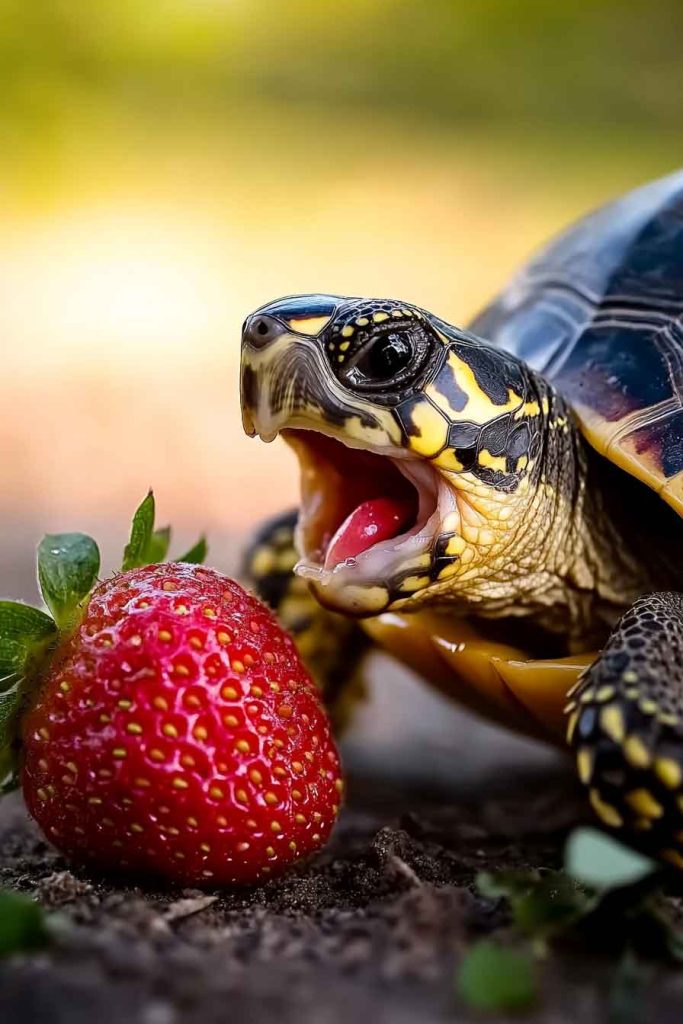
Turtles have evolved to eat a variety of foods in the wild, but their digestive systems are quite different from ours. While they can process strawberries, the high sugar content makes them unsuitable as a regular food item. Let me break down what’s actually in strawberries so you can understand why moderation is key.
Here’s what you’ll find in 100 grams of fresh strawberries:
- Carbohydrates: 7.68 g
- Sugar: 4.89 g
- Protein: 0.67 g
- Calcium: 16 mg
- Phosphorus: 24 mg
- Vitamin C: 58.8 mg
- Folate: 24 mcg
- Potassium: 153 mg
- Magnesium: 13 mg
- Iron: 0.41 mg
- Water: 90.95%
Looking at these numbers, I can see why strawberries need to be limited. The sugar content, while lower than many fruits, is still significant for a turtle’s sensitive digestive system. However, the high water content and vitamin C can be beneficial when given occasionally.
The calcium to phosphorus ratio in strawberries is about 2:3, which isn’t ideal. Turtles need more calcium than phosphorus in their diet, so strawberries shouldn’t be a major component of their nutrition plan.
Do Turtles Like Strawberries?
In my experience, most turtles absolutely love strawberries! The sweet taste and soft texture make them incredibly appealing. I’ve watched my turtle’s eyes light up (well, as much as turtle eyes can light up) when I offer a small piece of strawberry.
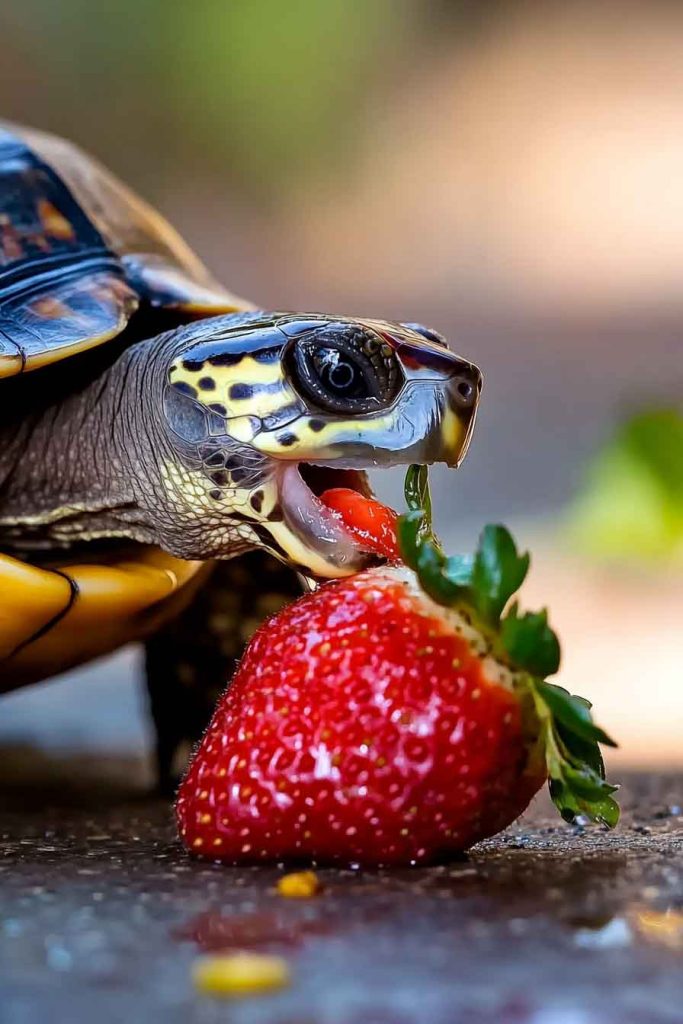
However, just because they like them doesn’t mean we should give them freely. I’ve learned that turtles don’t have the same dietary instincts that help them avoid foods that might not be the best for them in large quantities. It’s our job as their caretakers to provide what’s healthiest, not just what they enjoy most.
Health Benefits of Strawberries for Turtles
While strawberries should be limited, they do offer some genuine health benefits when given as an occasional treat:
Vitamin C Boost
Strawberries are packed with vitamin C, which supports immune system function. While turtles can synthesize some vitamin C on their own, a little extra from natural sources can be beneficial, especially during times of stress or illness.
Hydration Support
With over 90% water content, strawberries can help keep your turtle hydrated. This is particularly useful during warmer months or if your turtle seems reluctant to drink water directly.
Antioxidant Properties
The natural antioxidants in strawberries, including anthocyanins that give them their red color, can help combat free radicals and support overall health. These compounds may contribute to better cellular health and longevity.
Natural Enrichment
Beyond nutrition, offering variety in your turtle’s diet provides mental stimulation. The different texture, taste, and smell of strawberries can make mealtime more interesting and engaging for your pet.
Potential Health Risks of Feeding Strawberries to Turtles
Despite the benefits, there are several risks I always keep in mind when considering strawberries for my turtle:

Sugar Overload
The biggest concern I have with strawberries is their natural sugar content. Turtles’ digestive systems aren’t designed to handle large amounts of sugar. Too much can lead to digestive upset, diarrhea, and potentially contribute to obesity over time.
When I first started keeping turtles, I made the mistake of giving too many sweet treats. I quickly learned that what seems like a small amount to us can be overwhelming for a turtle’s system.
Calcium-Phosphorus Imbalance
The unfavorable calcium to phosphorus ratio in strawberries is another concern. If strawberries make up too large a portion of the diet, they could contribute to calcium deficiency over time. This is particularly dangerous for growing turtles who need optimal calcium for proper shell and bone development.
Potential Digestive Issues
Some turtles may be more sensitive to the natural acids in strawberries. I’ve noticed that a few turtles can experience mild digestive upset if they eat too many strawberries at once, showing signs like loose stools or reduced appetite.
Pesticide Concerns
If you’re not buying organic strawberries, there’s always the concern about pesticide residues. I always make sure to thoroughly wash any strawberries I give to my turtle, and when possible, I choose organic options.
How Much Strawberries Should Turtles Eat?
This is where portion control becomes crucial. Based on my research and experience, I follow these guidelines:
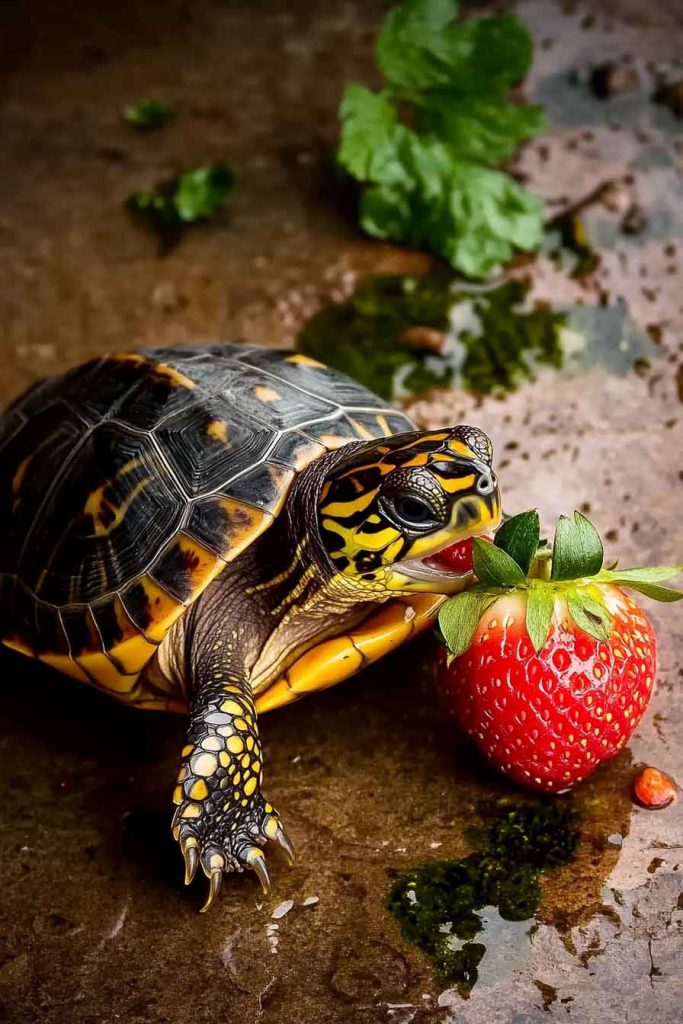
Adult Turtles
For adult turtles, I recommend limiting strawberries to about 1-2 small pieces once or twice per week maximum. The pieces should be no larger than the space between the turtle’s eyes – this is a good rule of thumb for any treat.
I always cut strawberries into small, manageable pieces. Not only does this prevent choking, but it also helps with portion control. A single medium strawberry can usually provide 3-4 appropriate servings for an adult turtle.
Frequency Guidelines
I never give strawberries more than twice in one week, and I prefer to space them out. If I give strawberries on Monday, I’ll wait until Thursday or Friday before offering them again. This ensures they remain a special treat rather than an expected part of the diet.
Can You Feed Strawberries to Baby Turtles?
Baby turtles require extra caution when it comes to treats like strawberries. Their digestive systems are still developing, and they need a diet that’s primarily focused on growth and development.
For baby turtles under one year old, I’m much more conservative. If I do offer strawberries, it’s only a tiny piece (smaller than a pea) and only once every two weeks at most. Their primary diet should consist of appropriate commercial turtle food and approved vegetables.
Many experts I’ve consulted actually recommend avoiding fruit treats entirely for baby turtles until they’re at least 6-8 months old. Their nutritional needs are so specific during this critical growth period that it’s better to focus on foods that directly support healthy development.
Preparing Strawberries for Your Turtle
When I do give strawberries to my turtle, I follow a specific preparation routine:
Washing
I always wash strawberries thoroughly under cold running water, even if they’re organic. I gently rub the surface to remove any dirt or potential contaminants.
Removing Tops
I remove the green leafy tops completely. While they’re not toxic, they can be difficult to digest and don’t add nutritional value.
Cutting
I cut strawberries into small, bite-sized pieces appropriate for my turtle’s size. For larger turtles, pieces about the size of a blueberry work well. For smaller turtles, I go even smaller.
Fresh Only
I only offer fresh strawberries, never frozen or processed ones. Frozen strawberries can be too cold and might cause digestive shock, while processed strawberries often contain added sugars or preservatives.
Alternative Healthy Treats for Turtles
While strawberries can be an occasional treat, I like to offer variety in my turtle’s diet. Here are some other safe, healthy treats I rotate through:
Vegetables (Primary Treats)
- Dark leafy greens (collard greens, dandelion greens)
- Squash varieties
- Bell peppers (red, yellow, orange)
- Carrots (in moderation)
Other Fruits (Occasional Treats)
- Blueberries (even better than strawberries due to lower sugar)
- Apple slices (without seeds)
- Cantaloupe (small amounts)
- Papaya
Protein Sources (For omnivorous species)
- Cooked chicken (small amounts)
- Fish (appropriate species)
- Insects (crickets, earthworms)
Species-Specific Considerations
Different turtle species have varying dietary needs, so I always consider my turtle’s specific requirements:
Box Turtles
Box turtles are omnivores and can handle fruit treats like strawberries better than some other species. However, I still limit them to the same portions I mentioned earlier.
Red-Eared Sliders
Red-eared sliders should have fruit treats limited to no more than 5% of their total diet. Since they’re prone to vitamin A deficiency, I prefer to focus their treat allowance on vitamin A-rich vegetables rather than fruits.
Painted Turtles
Similar to red-eared sliders, painted turtles should have minimal fruit in their diet. If I do offer strawberries, it’s very sparingly and always as part of a well-balanced overall diet.
Russian Tortoises
Russian tortoises are primarily herbivorous and can handle plant matter well, but I’m still cautious with high-sugar fruits like strawberries.
Signs to Watch For After Feeding Strawberries
Whenever I introduce any new food, including strawberries, I monitor my turtle closely for the next 24-48 hours. Here’s what I look for:
Positive Signs
- Normal appetite for regular foods
- Regular bathroom habits
- Active, alert behavior
- Clear eyes and nostrils
Warning Signs
- Diarrhea or unusually loose stools
- Loss of appetite
- Lethargy or unusual inactivity
- Vomiting (though this is rare in turtles)
If I notice any concerning symptoms, I immediately stop offering strawberries and contact my veterinarian if symptoms persist.
Creating a Balanced Diet Plan
I always remind fellow turtle owners that treats like strawberries should never exceed 10% of a turtle’s total diet. The foundation should always be:
Primary Diet (80-90%)
- High-quality commercial turtle pellets
- Appropriate vegetables for the species
- Proper calcium supplementation
Occasional Treats (5-10%)
- Fruits like strawberries
- Other safe treat options
- Variety for enrichment
Special Considerations (5%)
- Seasonal adjustments
- Health-specific modifications
- Age-appropriate changes
My Personal Experience and Tips
After years of keeping turtles, I’ve developed some personal strategies that work well:
I keep a food diary for my turtle, noting what treats I give and when. This helps me ensure I’m not overdoing it with any particular food, including strawberries.
I use strawberries as “high-value” treats for training or bonding. Since my turtle loves them so much, they’re perfect for encouraging positive behaviors or making vet visits less stressful.
I never give strawberries right before bedtime. The sugar content can sometimes make turtles more active, so I prefer to offer them earlier in the day.
Frequently Asked Questions (FAQs)
Can Box Turtles Eat Strawberries?
Yes, box turtles can eat strawberries as an occasional treat. Since they’re omnivores, they can handle fruit better than some species, but I still recommend the same portion control I mentioned earlier.
Can Red-Eared Slider Turtles Eat Strawberries?
Red-eared sliders can have strawberries occasionally, but I’m extra careful with portions. Their diet should be primarily vegetables and commercial foods, with fruits making up no more than 5% of their total intake.
Can Painted Turtles Eat Strawberries?
Painted turtles can have small amounts of strawberries, but like other aquatic species, their diet should focus more on vegetables and appropriate proteins rather than fruits.
Are Frozen Strawberries Safe for Turtles?
I don’t recommend frozen strawberries. The temperature can be shocking to their system, and the texture changes when frozen and thawed. Fresh strawberries are always the better choice.
What About Strawberry Leaves?
While strawberry leaves aren’t toxic, they’re not particularly nutritious for turtles either. I remove them and stick to just the fruit portion.
Can Turtles Eat Strawberry Jam or Processed Strawberry Products?
Absolutely not! Processed strawberry products contain added sugars, preservatives, and other ingredients that are harmful to turtles. Only fresh strawberries should be considered.
Conclusion
After all my research and experience, I can confidently say that strawberries can be a delightful occasional treat for your turtle when given responsibly. The key is moderation and understanding that they should never replace the core components of a healthy turtle diet.
Remember, every turtle is an individual, and what works for one might not work for another. I always encourage fellow turtle parents to observe their pets closely and consult with reptile veterinarians when in doubt.
The joy I see in my turtle’s behavior when I occasionally offer a small piece of strawberry is worth the careful preparation and portion control. It’s one of those simple pleasures that can enhance the bond between you and your shelled companion while still prioritizing their long-term health.
By following the guidelines I’ve shared in this article, you can safely include strawberries as part of a varied, enriching diet for your turtle. Just remember: moderation is key, observation is crucial, and your turtle’s overall health should always come first.
Happy turtle parenting, and I hope you and your turtle enjoy those special strawberry moments together!

